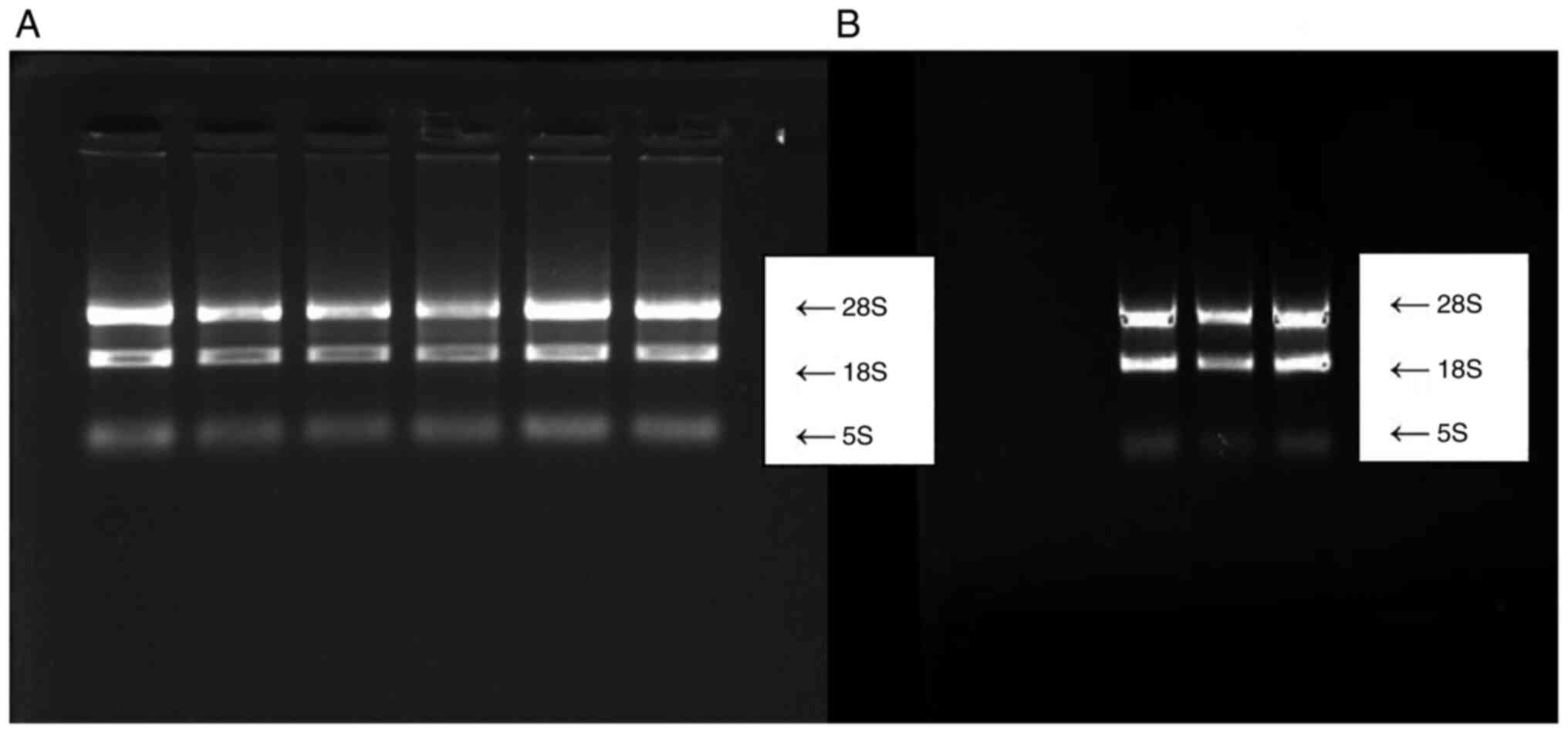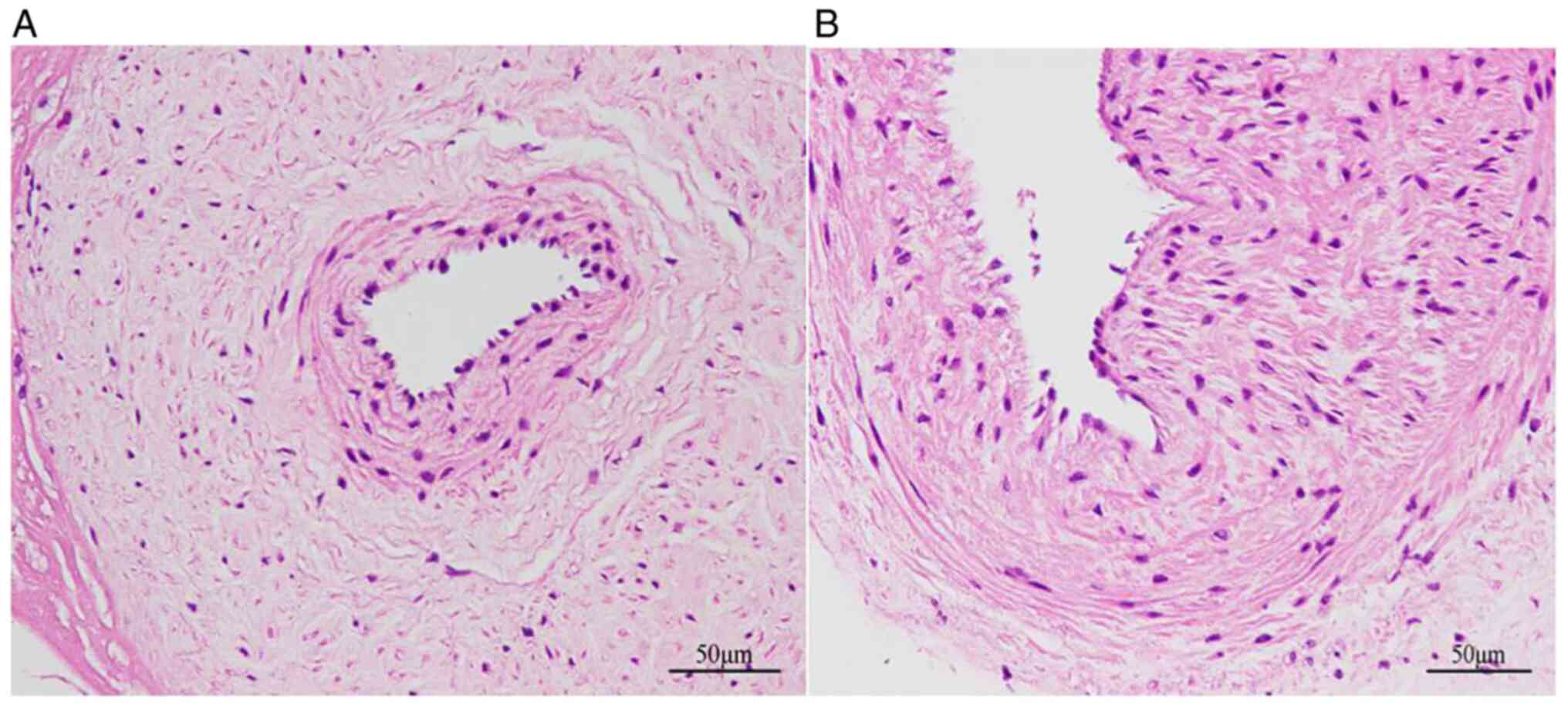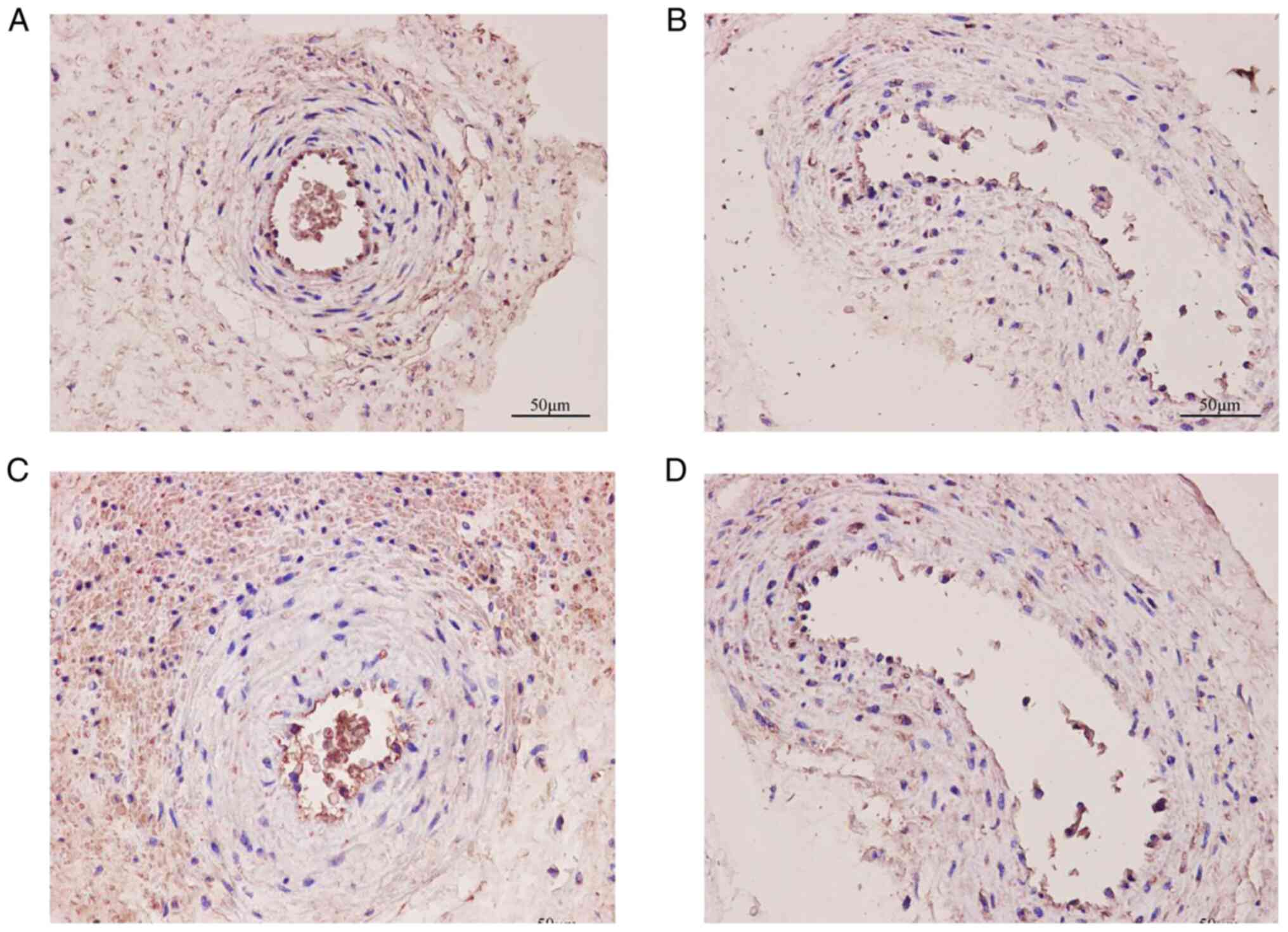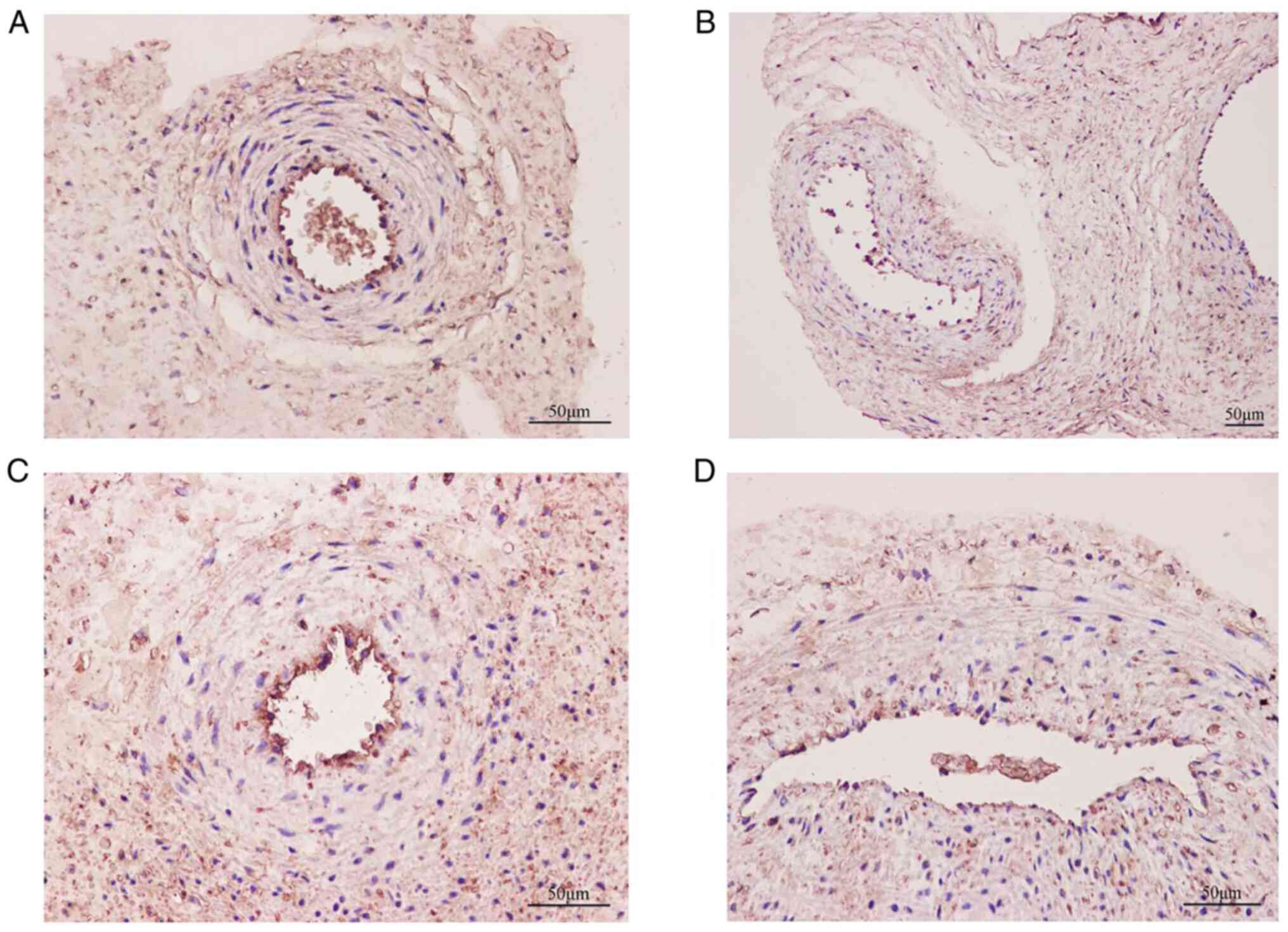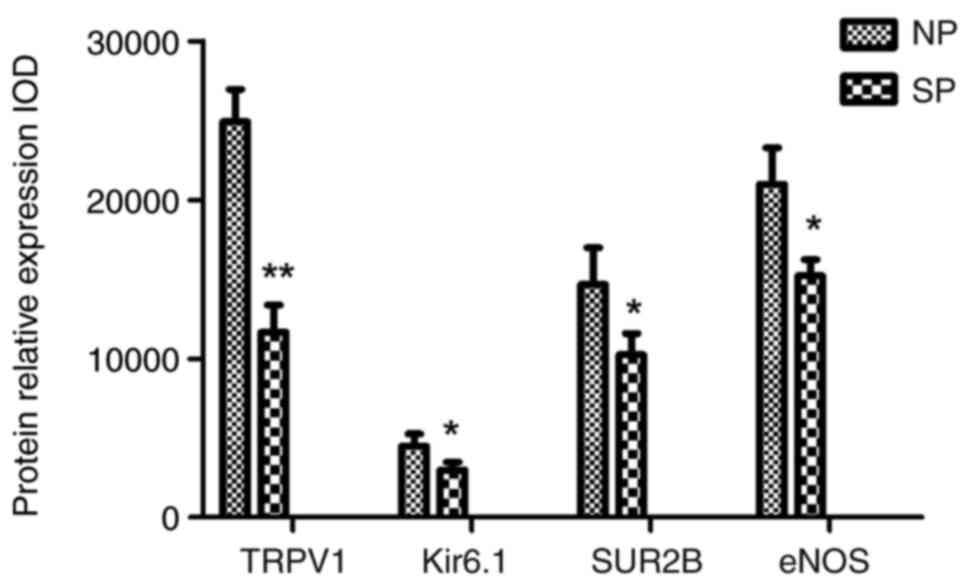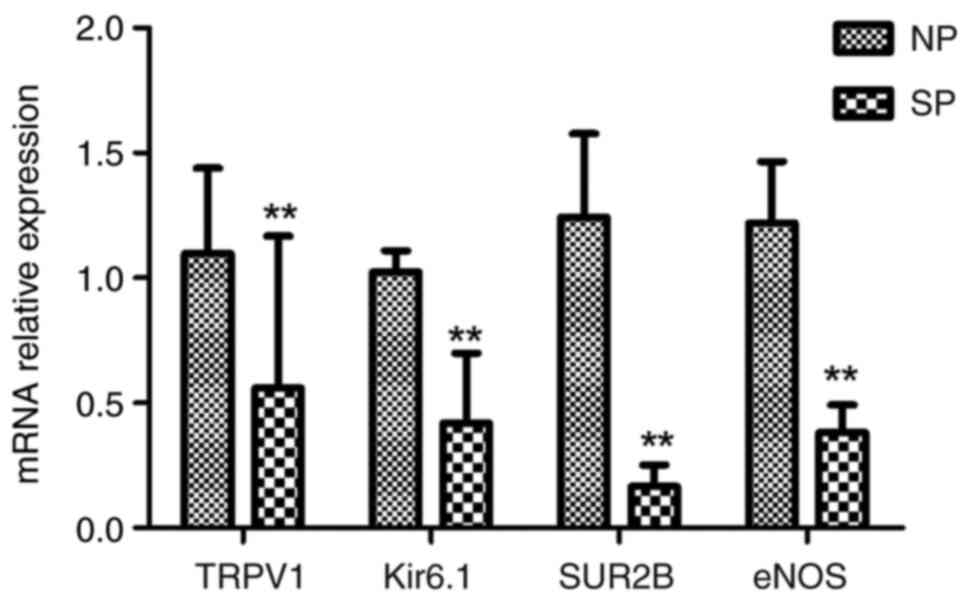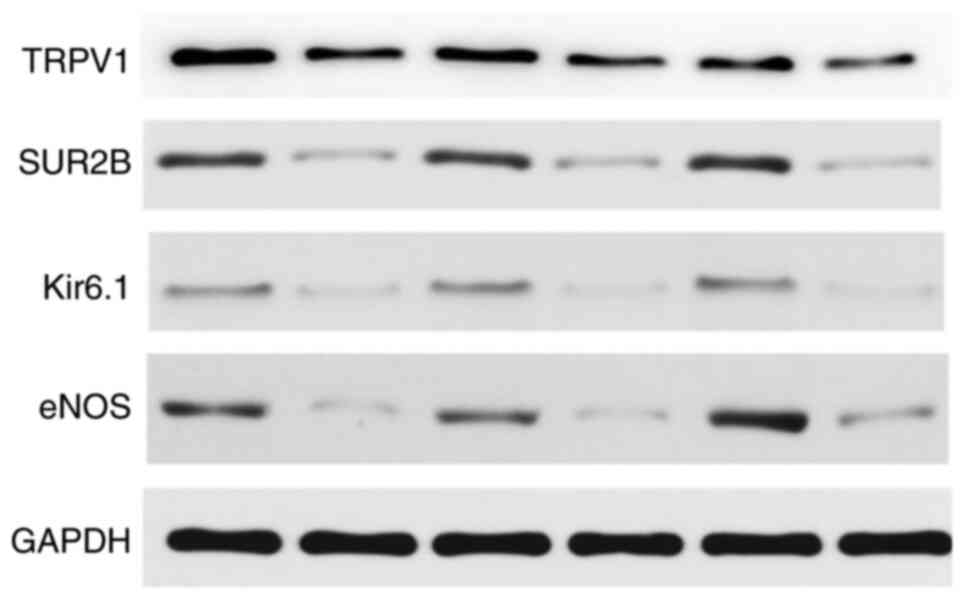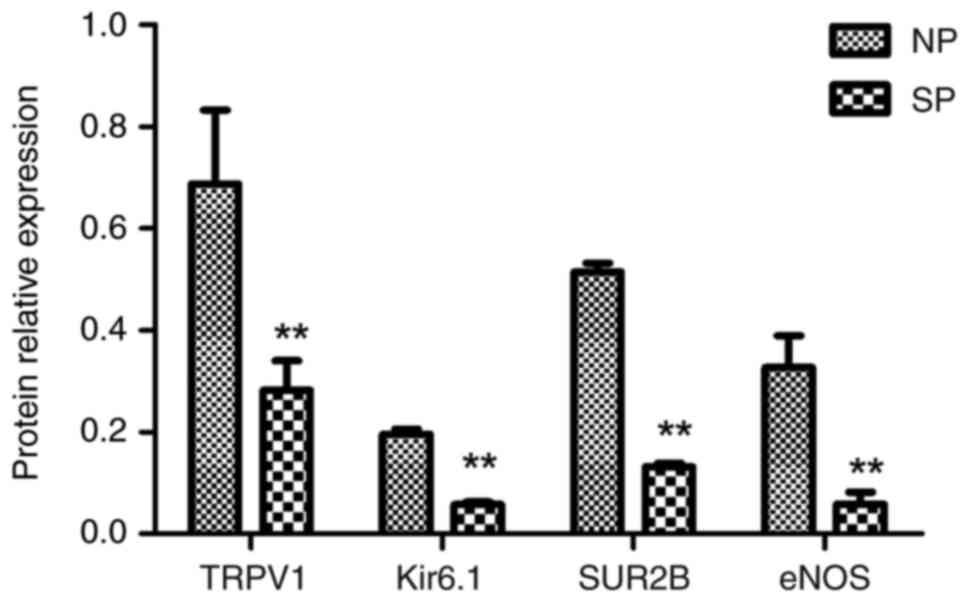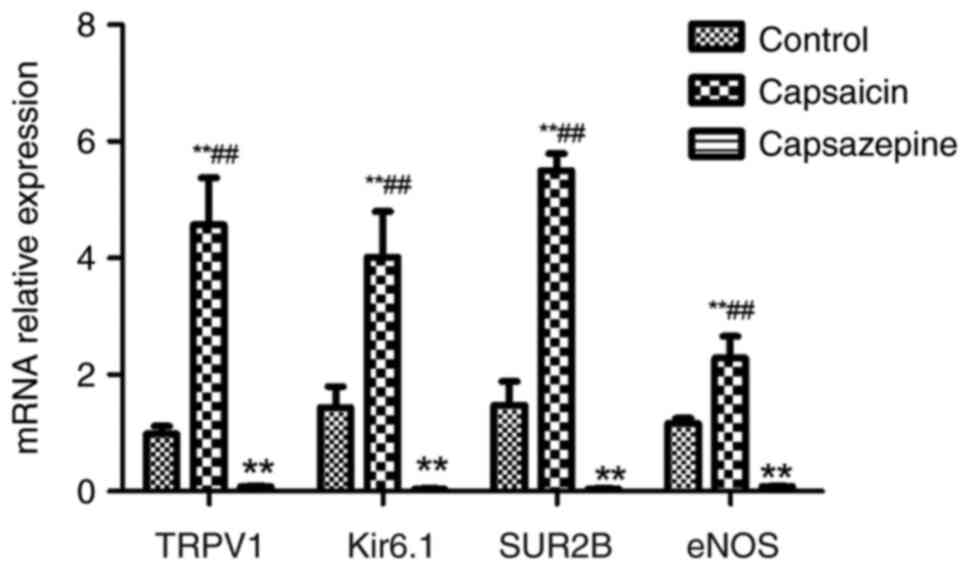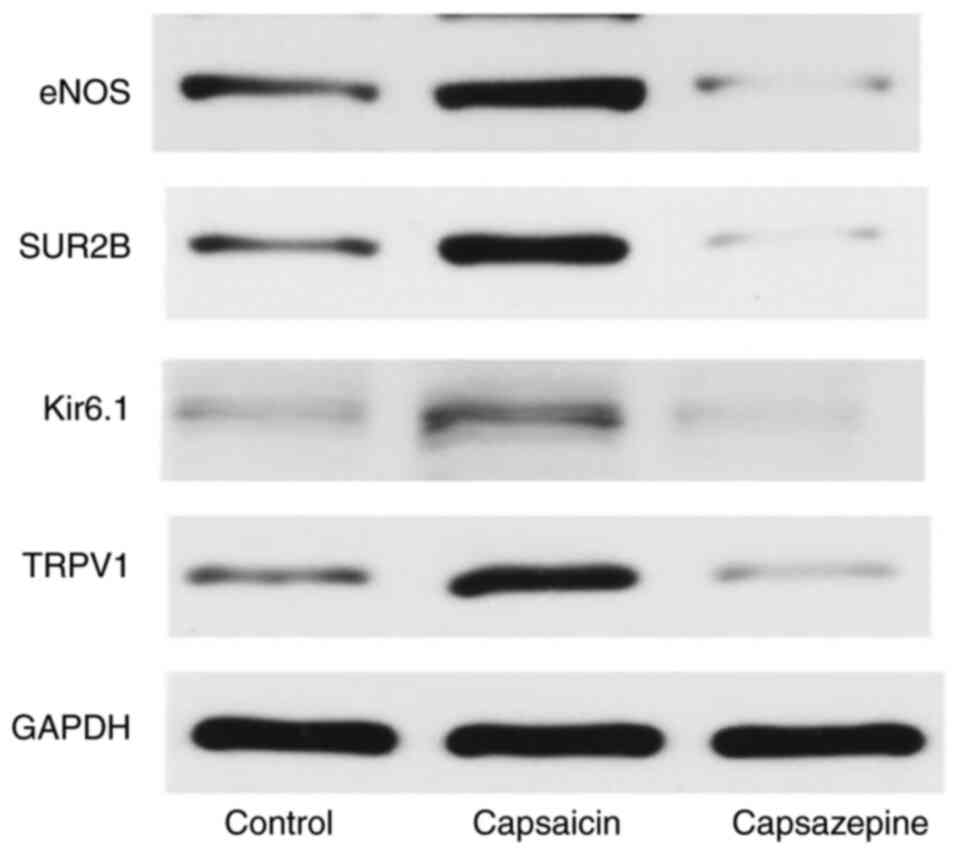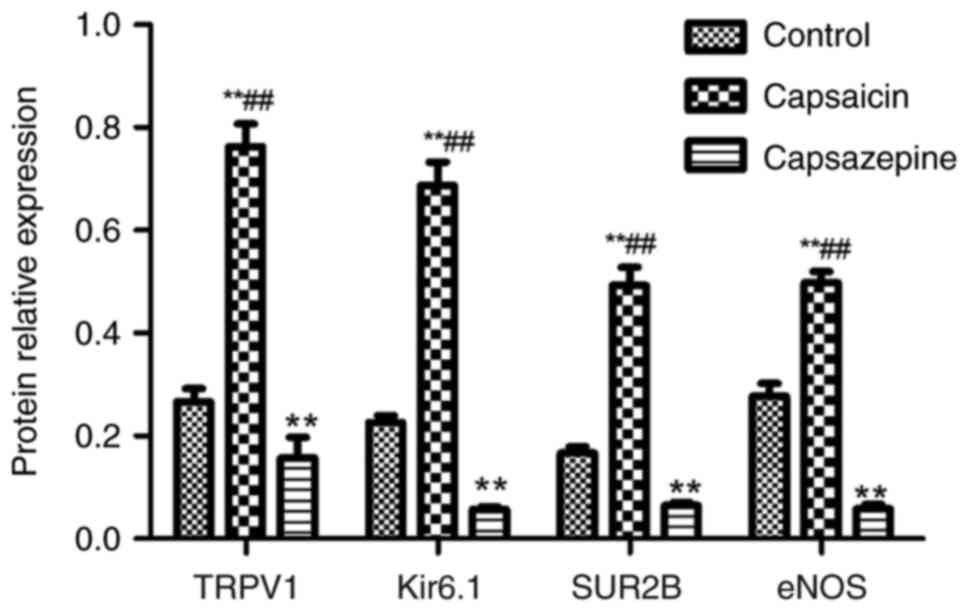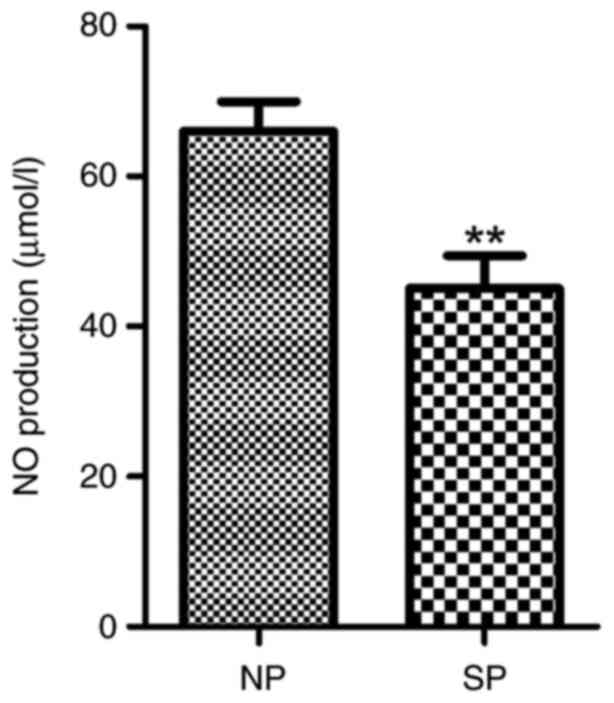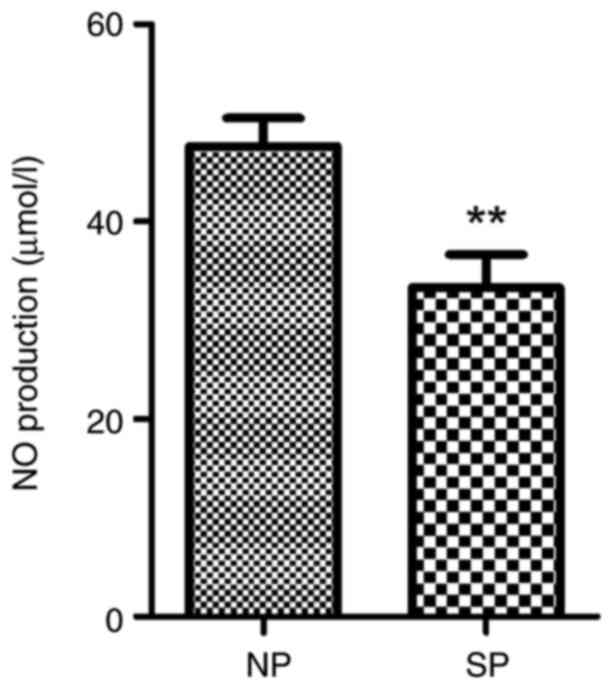|
1
|
Agrawal A and Wenger NK: Hypertension
during pregnancy. Curr Hypertens Rep. 22(64)2020.PubMed/NCBI View Article : Google Scholar
|
|
2
|
Hypertension in pregnancy. Report of the
american college of obstetricians and gynecologists' task force on
hypertension in pregnancy. Obstet Gynecol. 122:1122–1131.
2013.PubMed/NCBI View Article : Google Scholar
|
|
3
|
Zhu Z, Luo Z, Ma S and Liu D: TRP channels
and their implications in metabolic diseases. Pflugers Archiv.
461:211–223. 2011.PubMed/NCBI View Article : Google Scholar
|
|
4
|
Bratz IN, Dick GM, Tune JD, Edwards JM,
Neeb ZP, Dincer UD and Sturek M: Impaired capsaicin-induced
relaxation of coronary arteries in a porcine model of the metabolic
syndrome. Am J Physiol Heart Circ Physiol. 294:H2489–H2496.
2008.PubMed/NCBI View Article : Google Scholar
|
|
5
|
Marshall NJ, Liang L, Bodkin J,
Dessapt-Baradez C, Nandi M, Collot-Teixeira S, Smillie SJ, Lalgi K,
Fernandes ES, Gnudi L and Brain SD: A role for TRPV1 in influencing
the onset of cardiovascular disease in obesity. Hypertension.
61:246–252. 2013.PubMed/NCBI View Article : Google Scholar
|
|
6
|
Yang D, Luo Z, Ma S, Wong WT, Ma L, Zhong
J, He H, Zhao Z, Cao T, Yan Z, et al: Activation of TRPV1 by
dietary capsaicin improves endothelium-dependent vasorelaxation and
prevents hypertension. Cell Metab. 12:130–141. 2010.PubMed/NCBI View Article : Google Scholar
|
|
7
|
Yokoshiki H, Sunagawa M, Seki T and
Sperelakis N: ATP-sensitive K+ channels in pancreatic, cardiac, and
vascular smooth muscle cells. Am J Physiol. 274:C25–C37.
1998.PubMed/NCBI View Article : Google Scholar
|
|
8
|
Lückhoff A and Busse R: Activators of
potassium channels enhance calcium influx into endothelial cells as
a consequence of potassium currents. Naunyn Schmiedebergs Arch
Pharmacol. 342:94–99. 1990.PubMed/NCBI View Article : Google Scholar
|
|
9
|
Lückhoff A and Busse R: Calcium influx
into endothelial cells and formation of endothelium-derived
relaxing factor is controlled by the membrane potential. Pflugers
Arch. 416:305–311. 1990.PubMed/NCBI View Article : Google Scholar
|
|
10
|
Nelson MT, Cheng H, Rubart M, Santana LF,
Bonev AD, Knot HJ and Lederer WJ: Relaxation of arterial smooth
muscle by calcium sparks. Science. 270:633–637. 1995.PubMed/NCBI View Article : Google Scholar
|
|
11
|
Guarini G, Ohanyan VA, Kmetz JG,
DelloStritto DJ, Thoppil RJ, Thodeti CK, Meszaros JG, Damron DS and
Bratz IN: Disruption of TRPV1-mediated coupling of coronary blood
flow to cardiac metabolism in diabetic mice: Role of nitric oxide
and BK channels. Am J Physiol Heart Circ Physiol. 303:H216–H223.
2012.PubMed/NCBI View Article : Google Scholar
|
|
12
|
Roberts JM and Cooper DW: Pathogenesis and
genetics of pre-eclampsia. Lancet. 357:53–56. 2001.PubMed/NCBI View Article : Google Scholar
|
|
13
|
Vatish M, Randeva HS and Grammatopoulos
DK: Hormonal regulation of placental nitric oxide and pathogenesis
of pre-eclampsia. Trends Mol Med. 12:223–233. 2006.PubMed/NCBI View Article : Google Scholar
|
|
14
|
Gestational hypertension and preeclampsia:
ACOG Practice Bulletin, Number 222. Obstet Gynecol. 135:e237–e260.
2020.PubMed/NCBI View Article : Google Scholar
|
|
15
|
Zhang Z, Qu J, Zheng C, Zhang P, Zhou W,
Cui W, Mo X, Li L, Xu L and Gao J: Nrf2 antioxidant pathway
suppresses Numb-mediated epithelial-mesenchymal transition during
pulmonary fibrosis. Cell Death Dis. 9(83)2018.PubMed/NCBI View Article : Google Scholar
|
|
16
|
Li L, Li D, Xu L, Zhao P, Deng Z, Mo X, Li
P, Qi L, Li J and Gao J: Total extract of Yupingfeng attenuates
bleomycin-induced pulmonary fibrosis in rats. Phytomedicine.
22:111–119. 2015.PubMed/NCBI View Article : Google Scholar
|
|
17
|
Livak KJ and Schmittgen TD: Analysis of
relative gene expression data using real-time quantitative PCR and
the 2(-Delta Delta C(T)) method. Methods. 25:402–408.
2001.PubMed/NCBI View Article : Google Scholar
|
|
18
|
Moncada S, Palmer RM and Higgs EA: The
discovery of nitric oxide as the endogenous nitrovasodilator.
Hypertension. 12:365–372. 1988.PubMed/NCBI View Article : Google Scholar
|
|
19
|
Sumpio BE, Riley JT and Dardik A: Cells in
focus: Endothelial cell. Int J Biochem Cell Biol. 34:1508–1512.
2002.PubMed/NCBI View Article : Google Scholar
|
|
20
|
Konukoglu D and Uzun H: Endothelial
dysfunction and hypertension. Adv Exp Med Biol. 956:511–540.
2017.PubMed/NCBI View Article : Google Scholar
|
|
21
|
Al-Magableh MR, Kemp-Harper BK and Hart
JL: Hydrogen sulfide treatment reduces blood pressure and oxidative
stress in angiotensin II-induced hypertensive mice. Hypertens Res.
38:13–20. 2015.PubMed/NCBI View Article : Google Scholar
|
|
22
|
Osol G, Ko NL and Mandalà M: Altered
endothelial nitric oxide signaling as a paradigm for maternal
vascular maladaptation in preeclampsia. Curr Hypertens Rep.
19(82)2017.PubMed/NCBI View Article : Google Scholar
|
|
23
|
Reynolds LP and Redmer DA: Utero-placental
vascular development and placental function. J Anim Sci.
73:1839–1851. 1995.PubMed/NCBI View Article : Google Scholar
|
|
24
|
Zhou Y, Fisher SJ, Janatpour M, Genbacev
O, Dejana E, Wheelock M and Damsky CH: Human cytotrophoblasts adopt
a vascular phenotype as they differentiate. A strategy for
successful endovascular invasion? J Clin Invest. 99:2139–2151.
1997.PubMed/NCBI View Article : Google Scholar
|
|
25
|
Dikensoy E, Balat O, Pence S, Balat A,
Cekmen M and Yurekli M: The changes of plasma malondialdehyde,
nitric oxide, and adrenomedullin levels in patients with
preeclampsia. Hypertens Pregnancy. 28:383–389. 2009.PubMed/NCBI View Article : Google Scholar
|
|
26
|
Yallampalli C and Garfield RE: Inhibition
of nitric oxide synthesis in rats during pregnancy produces signs
similar to those of preeclampsia. Am J Obstet Gynecol.
169:1316–1320. 1993.PubMed/NCBI View Article : Google Scholar
|
|
27
|
Kaufmann P, Black S and Huppertz B:
Endovascular trophoblast invasion: Implications for the
pathogenesis of intrauterine growth retardation and preeclampsia.
Biol Reprod. 69:1–7. 2003.PubMed/NCBI View Article : Google Scholar
|
|
28
|
Boeldt DS and Bird IM: Vascular adaptation
in pregnancy and endothelial dysfunction in preeclampsia. J
Endocrinol. 232:R27–R44. 2017.PubMed/NCBI View Article : Google Scholar
|
|
29
|
Sahin-Tóth M, Kukor Z and Tóth M:
Tetrahydrobiopterin preferentially stimulates activity and promotes
subunit aggregation of membrane-bound calcium-dependent nitric
oxide synthase in human placenta. Mol Hum Reprod. 3:293–298.
1997.PubMed/NCBI View Article : Google Scholar
|
|
30
|
BROSENS I: A STUDY OF THE SPIRAL ARTERIES
OF THE DECIDUA BASALIS IN NORMOTENSIVE AND HYPERTENSIVE
PREGNANCIES. J Obstet Gynaecol Br Commonw. 71:222–230.
1964.PubMed/NCBI View Article : Google Scholar
|
|
31
|
Caterina MJ, Schumacher MA, Tominaga M,
Rosen TA, Levine JD and Julius D: The capsaicin receptor: A
heat-activated ion channel in the pain pathway. Nature.
389:816–824. 1997.PubMed/NCBI View
Article : Google Scholar
|
|
32
|
Caterina MJ: Vanilloid receptors take a
TRP beyond the sensory afferent. Pain. 105:5–9. 2003.PubMed/NCBI View Article : Google Scholar
|
|
33
|
Yang XR, Lin MJ, McIntosh LS and Sham JS:
Functional expression of transient receptor potential melastatin-
and vanilloid-related channels in pulmonary arterial and aortic
smooth muscle. Am J Physiol Lung Cell Mol Physiol. 290:L1267–L1276.
2006.PubMed/NCBI View Article : Google Scholar
|
|
34
|
Zsombok A: Vanilloid receptors-do they
have a role in whole body metabolism? Evidence from TRPV1. J
Diabetes Complications. 27:287–292. 2013.PubMed/NCBI View Article : Google Scholar
|
|
35
|
Gunthorpe MJ and Szallasi A: Peripheral
TRPV1 receptors as targets for drug development: New molecules and
mechanisms. Curr Pharm Des. 14:32–41. 2008.PubMed/NCBI View Article : Google Scholar
|
|
36
|
Xin H, Tanaka H, Yamaguchi M, Takemori S,
Nakamura A and Kohama K: Vanilloid receptor expressed in the
sarcoplasmic reticulum of rat skeletal muscle. Biochem Biophys Res
Commun. 332:756–762. 2005.PubMed/NCBI View Article : Google Scholar
|
|
37
|
Song MY and Yuan JX: Introduction to TRP
channels: Structure, function, and regulation. Adv Exp Med Biol.
661:99–108. 2010.PubMed/NCBI View Article : Google Scholar
|
|
38
|
Cai H, Davis ME, Drummond GR and Harrison
DG: Induction of endothelial NO synthase by hydrogen peroxide via a
Ca(2+)/calmodulin-dependent protein kinase II/janus kinase
2-dependent pathway. Arterioscler Thromb Vasc Biol. 21:1571–1576.
2001.PubMed/NCBI View Article : Google Scholar
|
|
39
|
Zhang M and Vogel HJ: Characterization of
the calmodulin-binding domain of rat cerebellar nitric oxide
synthase. J Biol Chem. 269:981–985. 1994.PubMed/NCBI
|
|
40
|
Zhang M, Yuan T, Aramini JM and Vogel HJ:
Interaction of calmodulin with its binding domain of rat cerebellar
nitric oxide synthase. A multinuclear NMR study. J Biol Chem.
270:20901–20907. 1995.PubMed/NCBI View Article : Google Scholar
|
|
41
|
Torres-Narváez JC, Pérez-Torres I,
Castrejón-Téllez V, Varela-López E, Oidor-Chan VH, Guarner-Lans V,
Vargas-González Á, Martínez-Memije R, Flores-Chávez P,
Cervantes-Yañez EZ, et al: The role of the activation of the TRPV1
receptor and of nitric oxide in changes in endothelial and cardiac
function and biomarker levels in hypertensive rats. Int J Environ
Res Public Health. 16(3576)2019.PubMed/NCBI View Article : Google Scholar
|
|
42
|
Nieves-Cintrón M, Syed AU, Nystoriak MA
and Navedo MF: Regulation of voltage-gated potassium channels in
vascular smooth muscle during hypertension and metabolic disorders.
Microcirculation. 25:2018.PubMed/NCBI View Article : Google Scholar
|
|
43
|
Jackson WF: KV channels and the
regulation of vascular smooth muscle tone. Microcirculation.
25:2018.PubMed/NCBI View Article : Google Scholar
|
|
44
|
Wu Y, He MY, Ye JK, Ma SY, Huang W, Wei
YY, Kong H, Wang H, Zeng XN and Xie WP: Activation of ATP-sensitive
potassium channels facilitates the function of human endothelial
colony-forming cells via Ca2+/Akt/eNOS pathway. J Cell
Mol Med. 21:609–620. 2017.PubMed/NCBI View Article : Google Scholar
|
|
45
|
Chen X, Han W, Zhang Y, Cui W, Pan Z, Jin
X, Long C and Wang H: The molecular pathway of ATP-sensitive
potassium channel in endothelial cells for mediating arteriole
relaxation. Life Sci. 137:164–169. 2015.PubMed/NCBI View Article : Google Scholar
|
|
46
|
Breyne J and Vanheel B: Methanandamide
hyperpolarizes gastric arteries by stimulation of TRPV1 receptors
on perivascular CGRP containing nerves. J Cardiovasc Pharmacol.
47:303–309. 2006.PubMed/NCBI View Article : Google Scholar
|















